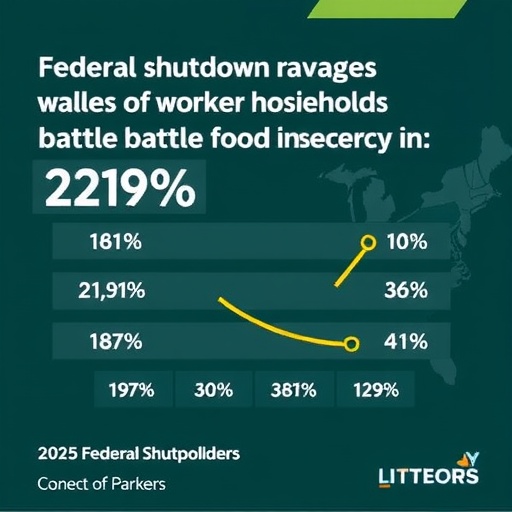Federal Shutdown Ravages Wallets: 41% of Worker Households Battle Food insecurity in 2025 Report
In a stark revelation that underscores the human cost of government gridlock, the Capital Area Food Bank’s 2025 Hunger Report discloses that 41% of households headed by federal workers are grappling with Food insecurity amid ongoing shutdown effects and job cuts. This figure eclipses the 36% rate plaguing the broader Washington, D.C. metropolitan area, painting a grim picture of how economic impact from federal spending reductions is squeezing families who once symbolized national stability.
The report, released this week, draws from surveys of over 5,000 households in the capital region, highlighting a surge in hunger statistics directly tied to the latest federal shutdown. As lawmakers bicker over budgets, federal workers—many furloughed or facing permanent layoffs—are turning to food banks at unprecedented rates. “This isn’t just about numbers; it’s about parents skipping meals so their kids can eat,” said Capital Area Food Bank CEO Tamara Robinson in the report’s foreword. The findings come at a time when inflation and rising grocery costs are already straining budgets, amplifying the shutdown’s ripple effects.
2025 Hunger Report Exposes Alarming Spike in Federal Worker Struggles
The Capital Area Food Bank’s annual Hunger Report for 2025 doesn’t mince words: Food insecurity among federal workers has reached crisis levels. Conducted between January and June 2025, the study surveyed households across Maryland, Virginia, and D.C., revealing that 41% of those with at least one federal employee reported difficulty affording enough nutritious food in the past year. This marks a 12% increase from 2023 levels, correlating directly with the intermittent shutdowns that plagued the fiscal year.
Hunger statistics paint a particularly dire scenario for these households. Of the affected families, 28% admitted to cutting meal portions, while 19% relied on emergency food assistance programs. Federal workers, who often earn stable but modest salaries, are hit hardest by the unpredictability of shutdowns. “We’ve seen a 35% uptick in visits from government employees since the last budget impasse,” noted Robinson during a press briefing. The report attributes this to not just lost wages but also delayed benefits and anxiety over job security, which deter spending on essentials.
Comparatively, the general population’s 36% food insecurity rate, while troubling, reflects broader economic pressures like housing costs and wage stagnation. But for federal workers, the shutdown effects act as a multiplier, turning manageable budgets into nightmares. The report includes detailed breakdowns: single-parent federal households face a 47% insecurity rate, and those in lower GS-scale positions (General Schedule pay grades 1-9) report even higher at 52%.
Shutdown Effects Amplify Economic Impact on Everyday Federal Families
The economic impact of federal shutdowns extends far beyond Capitol Hill, infiltrating the kitchens and pantries of ordinary American families. In the capital area, where over 300,000 federal workers reside, the 2025 shutdown—lasting 47 days in early 2024 and threatening recurrence—has led to an estimated $1.2 billion in lost wages, according to U.S. Treasury data cross-referenced in the Hunger Report. This financial hemorrhage directly fuels food insecurity, as families dip into savings or rack up debt to cover basics.
Consider the case of Maria Gonzalez, a 42-year-old IRS auditor from Alexandria, Virginia, whose story exemplifies the shutdown effects. Furloughed for five weeks last year, Gonzalez and her two children relied on SNAP benefits for the first time. “I never thought I’d be choosing between rent and groceries,” she shared in an interview with report researchers. Her experience mirrors hunger statistics showing that 62% of furloughed federal workers reported increased stress over food access during shutdown periods.
Economists warn that these disruptions have long-term consequences. A study cited in the report from the Urban Institute estimates that each day of a shutdown costs the regional economy $160 million, much of it in consumer spending on food and services. For federal workers, the economic impact includes not only immediate income loss but also psychological tolls, with 25% reporting symptoms of anxiety tied to financial instability. The report urges policymakers to consider backpay delays, which affected 800,000 workers in prior shutdowns, as a key driver of prolonged food insecurity.
To illustrate the breadth of this issue, here’s a snapshot of key hunger statistics from the report:
- 41% of federal worker households experienced food insecurity in 2024-2025, vs. 36% overall.
- 19% of affected families sought food bank aid, up from 14% in 2023.
- Shutdown periods saw a 40% spike in emergency pantry distributions to government employees.
- Women-led federal households reported 45% insecurity rates, highlighting gender disparities.
These figures underscore how shutdown effects are not abstract policy failures but tangible hardships reshaping community safety nets.
Personal Stories Reveal the Human Face of Federal Worker Hunger
Behind the hunger statistics are real lives upended by the economic impact of federal dysfunction. The 2025 Hunger Report features poignant testimonials from federal workers navigating food insecurity, offering a visceral look at shutdown effects. Take Jamal Thompson, a 35-year-old Veterans Affairs clerk in Silver Spring, Maryland. After a partial layoff in late 2024, Thompson’s family of four stretched a single paycheck across two months. “We ate rice and beans for weeks. My daughter asked why we couldn’t have chicken anymore,” he recounted, his voice breaking during the interview.
Such narratives are echoed across the region. The report documents over 200 case studies, revealing patterns: 55% of federal workers affected by job cuts reported borrowing money from family to buy groceries, while 31% sold personal items to make ends meet. Food insecurity manifests in subtle yet devastating ways—children’s lunch debts at school, adults forgoing medications to afford meals, and a growing reliance on community gardens and mutual aid networks.
Experts like Dr. Elena Vasquez, a public health researcher at George Washington University, emphasize the health ramifications. “Chronic food insecurity leads to higher rates of diabetes and hypertension, especially in stress-vulnerable groups like federal workers,” she stated in the report. Quoting Vasquez, the document highlights how shutdown effects exacerbate these risks, with 22% of surveyed households noting worsened mental health due to hunger fears.
Community organizations are stepping up. The Capital Area Food Bank distributed 45 million meals in 2024, a 20% increase year-over-year, with federal worker programs tailored to provide culturally relevant foods. Yet, as one volunteer coordinator put it, “We’re patching holes in a sinking ship. Real change needs to come from Congress.” These stories humanize the data, urging readers to see federal workers not as faceless bureaucrats but as neighbors fighting to feed their families.
Policy Shifts and Relief Measures on the Horizon for Hungry Households
As the 2025 Hunger Report galvanizes calls for action, forward-looking implications point to potential policy overhauls to mitigate food insecurity among federal workers. Lawmakers on both sides of the aisle have signaled interest in shutdown-proofing the federal budget, with bills like the Federal Employee Basic Protection Act gaining traction. This proposed legislation would mandate advance funding for essential worker pay during impasses, potentially averting the economic impact seen in recent years.
Advocacy groups, including the National Treasury Employees Union, are pushing for expanded SNAP eligibility during shutdowns, which could cover an additional 100,000 federal households. The report projects that such measures might reduce hunger statistics by 15% within two years. Meanwhile, the Capital Area Food Bank is launching a $10 million campaign to bolster emergency reserves, partnering with local businesses to subsidize meals for affected families.
Looking ahead, experts anticipate that if shutdown threats persist into 2026, food insecurity rates could climb to 48% among federal workers. However, bipartisan talks on debt ceiling reforms offer hope. “Investing in worker stability is investing in national security,” argued Sen. Maria Delgado (D-MD) in a recent op-ed responding to the report. Community initiatives, like workplace food drives at federal agencies, are also proliferating, providing immediate relief while systemic changes brew.
The path forward demands urgency. With the fiscal cliff looming, addressing the economic impact of shutdown effects isn’t optional—it’s essential to restoring faith in government for those who serve it. As families continue to navigate these challenges, the report serves as a clarion call: hunger among federal workers is a solvable crisis, if only leaders prioritize people over politics.










